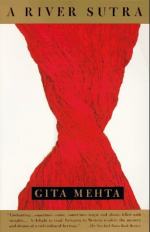|
This section contains 844 words (approx. 3 pages at 300 words per page) |

|
SOURCE: Greenlaw, Lavinia. “A River View.” Times Literary Supplement, no. 4705 (4 June 1993): 23.
In the following review, Greenlaw applauds Mehta for constructing an insightful and flowing narrative in A River Sutra, complimenting the novel's skillful use of fables as representations of modern Indian culture.
The glossary at the back of A River Sutra tells us that sutra has two meanings: an aphoristic literary form, and a string or thread. In this book, the two usages are simultaneously employed, as a simple narrative carries the reader through a careful arrangement of interlocking didactic tales. Gita Mehta's skillfully constructed second novel follows the experiences of an Indian bureaucrat who retires to run a government resthouse, in the jungle by the sacred Narmada river. He has become a vanaprasthi, “someone who has retired to the forest to reflect”. The Narmada is the focus of his meditations, and its many historical and mythological associations...
|
This section contains 844 words (approx. 3 pages at 300 words per page) |

|


